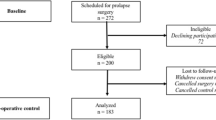Abstract
Objectives
The aim of this study was to evaluate the stiffness variation of the levator ani in patients with stage I/II pelvic organ prolapse (POP) before and after Kegel exercises by transperineal elastography.
Methods
A total of 20 patients who were diagnosed with staged I/II POP underwent conventional transperineal ultrasound and elastography. For each patient, the levator ani was located and evaluated in the state of Valsalva. After Kegel exercises for 12 weeks, transperineal ultrasound and elastography were repeated. The elasticity images were assessed using a four-point scale scoring system.
Results
Of the 20 cases, four had an elastography score of 1, 14 had a score of 2, two had a score of 3, and no cases had a score of 4 in the levator ani before Kegel exercises. After Kegel exercises, one had an elastography score of 1, two had a score of 2, 15 had a score of 3, and two cases had a score of 4. The mean elastography score was statistically significantly higher for the levator ani after Kegel exercises (2.90 ± 0.48) than for the baseline score (1.90 ± 0.29) (p = 0.025).
Conclusions
Transperineal elastography was an effective and useful tool in the evaluation of the levator ani in patients with POP-Q stage I/II before and after Kegel exercises.


Similar content being viewed by others
References
Swift SE, Woodman P, Boyle A, et al. Pelvic Organ Support Study (POSST): the distribution, clinical definition and epidemiology of pelvic organ support defects. Am J Obstet Gynecol. 2005;192:795–806.
Lamin Eliza, Parrillo Lisa M, Newman Diane K, et al. Pelvic floor muscle training: underutilization in the USA. Curr Urol Rep. 2016;17:10.
Kegel AH. Progressive resistance exercise in the functional restoration of the perineal muscles. Am J Obstet Gynecol. 1948;56:238–48.
Ferreira Cristine Homsi Jorge, Dwyer Peter L, Davidson Melissa, et al. Does pelvic floor muscle training improve female sexual function? A systematic review. Int Urogynecol J. 2015;26:1735–50.
Braekken IH, Majida M, Ellstrom-Engh M, et al. Test-retest and intra-observer repeatability of two-, three- and four-dimensional perineal ultrasound of pelvic floor muscle anatomy and function. Int Urogynecol J Pelvic Floor Dysfunct. 2008;19:227–35.
Majida M, Braekken IH, Umek W, et al. Interobserver repeatability of three- and four-dimensional transperineal ultrasound assessment of pelvic floor muscle anatomy and function. Ultrasound Obstet Gynecol. 2009;33:567–73.
Dietz HP, Shek C, Clarke B. Biometry of the pubovisceral muscle and levator hiatus by three-dimensional pelvic floor ultrasound. Ultrasound Obstet Gynecol. 2005;25:580–5.
Shiina T, Nightingale KR, Palmeri ML, et al. WFUMB guidelines and Recommendations for clinical use of ultrasound elastography: part 1: basic principles and terminology. Ultrasound Med Biol. 2015;41:1126–47.
Xie M, Zhang X, Liu J, et al. Evaluation of levator ani with no defect on elastography in women with POP. Int J Clin Exp Med. 2015;8:10204–12.
Cavkaytar S, Kokanali MK, Topcu HO, et al. Effect of home-based Kegel exercises on quality of life in women with stress and mixed urinary incontinence. J Obstet Gynaecol. 2015;35:407–10.
Delancey JO, Kearney R, Chou Q, et al. The appearance of levator ani muscle abnormalities in magnetic resonance images after vaginal delivery. Obstet Gynecol. 2003;101:46–53.
Albrich SB, Laterza RM, Skala C, et al. Impact of mode of delivery on levator morphology: a prospective observational study with three dimensional ultrasound early in the postpartum period. BJOG. 2012;119:51–60.
Valsky DV, Lipschuetz M, Bord A, et al. Fetal head circumference and length of second stage of labour are risk factors for levator ani muscle injury, diagnosed by 3-dimensional transperineal ultrasound in primiparous women. Am J Obstet Gynecol. 2009;201:91.e1–7.
Aydın Serdar, Tuncel Muazzez Ayça, Aydın ÇA, et al. Do we protect the pelvic floor with non-elective cesarean? A study of 3-D/4-D pelvic floor ultrasound immediately after delivery. J Obstet Gynaecol. 2014;40:1037–45.
Braekken IH, Majida M, Engh ME, et al. Morphological changes after pelvic floor muscle training measured by 3-dimensional ultrasonography: a randomized controlled trial. Obstet Gynecol. 2010;115:317–24.
Dietz HP, Wilson PD, Clarke B. The use of perineal ultrasound to quantify levator activity and teach pelvic floor muscle exercises. Int Urogynecol J Pelvic Floor Dysfunct. 2001;12:166–8 (discussion 168–169).
Van DK, Thakar R, Sultan AH. Pelvic floor muscle contractility: digital assessment vs transperineal ultrasound. Ultrasound Obstet Gynecol. 2015;45:217–22.
Chen L, Low LK, Delancey JO, et al. In vivo estimation of perineal body properties using ultrasound quasistatic elastography in nulliparous women. J Biomech. 2015;48:1575–9.
Aljuraifani Rafeef, Stafford Ryan E, Hug François, et al. Female striated urogenital sphincter contraction measured by shear wave elastography during pelvic floor muscle activation: proof of concept and validation. Neurourol Urodyn. 2017;9999:1–7.
Stafford Ryan E, Aljuraifani Rafeef, Hug Francois, et al. Application of shear-wave elastography to estimate the stiffness of the male striated urethral sphincter during voluntary contractions. BJU Int. 2017;119:619–25.
Kreutzkamp JM, Schäfer SD, Amler S, et al. Strain elastography as a new method for assessing pelvic floor biomechanics. Ultrasound Med Biol. 2017;43:868–72.
Dietz HP. Clinical consequences of levator trauma. Ultrasound Obstet Gynecol. 2012;39:367–71.
Staerjensen J, Braekken IH, et al. Learning process for performing and analyzing 3D/4D transperineal ultrasound imaging and interobserver reliability study. Ultrasound Obstet Gynecol. 2013;41:312–7.
Author information
Authors and Affiliations
Contributions
MX performed elastography and ultrasound. XZ wrote paper. XZ analyzed data, recruited patients. WW analyzed images. KH designed study, revised paper.
Corresponding author
Ethics declarations
Conflict of interest
We declare that we have no conflicts of interest.
About this article
Cite this article
Xie, M., Zhang, X., Zhang, X. et al. Can we evaluate the levator ani after Kegel exercise in women with pelvic organ prolapse by transperineal elastography? A preliminary study. J Med Ultrasonics 45, 437–441 (2018). https://doi.org/10.1007/s10396-018-0862-5
Received:
Accepted:
Published:
Issue Date:
DOI: https://doi.org/10.1007/s10396-018-0862-5




